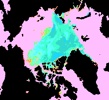 The Arctic sea ice has begun its autumn freeze after setting a new record for a summer low – a million square kilometres less than the previous record, set in 2005. The NSIDC updates are very interesting, while scientists working in the field described the summer as “remarkable
The Arctic sea ice has begun its autumn freeze after setting a new record for a summer low – a million square kilometres less than the previous record, set in 2005. The NSIDC updates are very interesting, while scientists working in the field described the summer as “remarkable
Tag: Arctic sea ice
Arctic ice sets new record
 I follow the Arctic sea ice extent at Cryosphere Today. The site publishes pictures, maps and graphs of sea ice in the Arctic and Antarctic, derived from NASA satellite data. They’ve just announced a worrying new record:
I follow the Arctic sea ice extent at Cryosphere Today. The site publishes pictures, maps and graphs of sea ice in the Arctic and Antarctic, derived from NASA satellite data. They’ve just announced a worrying new record:
Today (August 9th), the Northern Hemisphere sea ice area broke the record for the lowest recorded ice area in recorded history. The new record came a full month before the historic summer minimum typically occurs. There is still a month or more of melt likely this year. It is therefore almost certain that the previous 2005 record will be annihilated by the final 2007 annual minima closer to the end of this summer. In previous record sea ice minima years, ice area anomalies were confined to certain sectors (N. Atlantic, Beaufort/Bering Sea, etc). The character of 2007’s sea ice melt is unique in that it is dramatic and covers the entire Arctic sector. Atlantic, Pacific and even the central Arctic sectors are showing large negative sea ice area anomalies.
I find this news disturbing for two reasons. First, the fact that the new record should be set so early in the season. That suggests that there is a lot more melting to go. The second is the language: normally cautious scientists seldom use words like “annihilate
Melting at both ends
Arctic sea ice is melting. The Greenland ice sheet is losing mass, and the Antarctic Peninsula is one of the fastest warming parts of the planet. But the main part of Antarctica has often been assumed to be pretty safe from extensive surface melting. It’s very cold, and very high. NASA now reports that in January 2005, large parts of the surface of West Antarctica experienced a week long melt, the first time this has been seen.
“The observed melting occurred in multiple distinct regions, including far inland, at high latitudes and at high elevations, where melt had been considered unlikely. Evidence of melting was found up to 900 kilometers (560 miles) inland from the open ocean, farther than 85 degrees south (about 500 kilometers, or 310 miles, from the South Pole) and higher than 2,000 meters (6,600 feet) above sea level. Maximum air temperatures at the time of the melting were unusually high, reaching more than five degrees Celsius (41 degrees Fahrenheit) in one of the affected areas. They remained above melting for approximately a week.”
The picture accompanying the NASA story clearly shows large melt areas – the size of California (how many Belgiums is that?) – over the West Antarctic ice sheet. There hasn’t been a repeat of the event in the last two years, and the period studied only began in 1999, so it’s not clear how unusual the melt was, or if there is any trend. Given the concerns about the stability of the West Antarctic ice sheet in a warming world, this news will add urgency to this year’s International Polar Year effort (which is getting a bit of help from the International Space Station).
Arctic sea ice melting faster than expected
Arctic sea ice is melting faster than modelling (and the IPCC) predicts, the US National Snow and Ice Data Centre (NSIDC) reports.
The shrinking of summertime ice is about thirty years ahead of the climate model projections,
